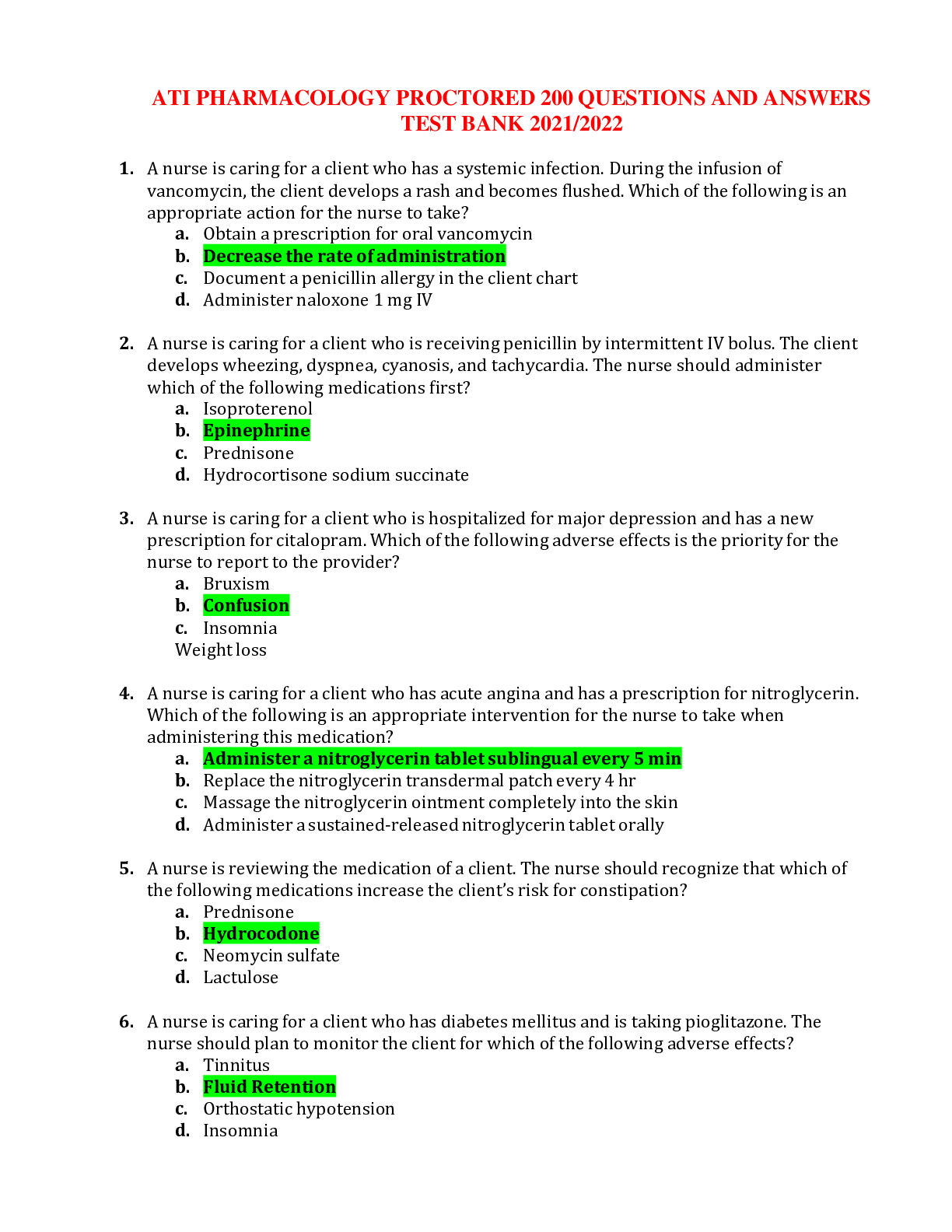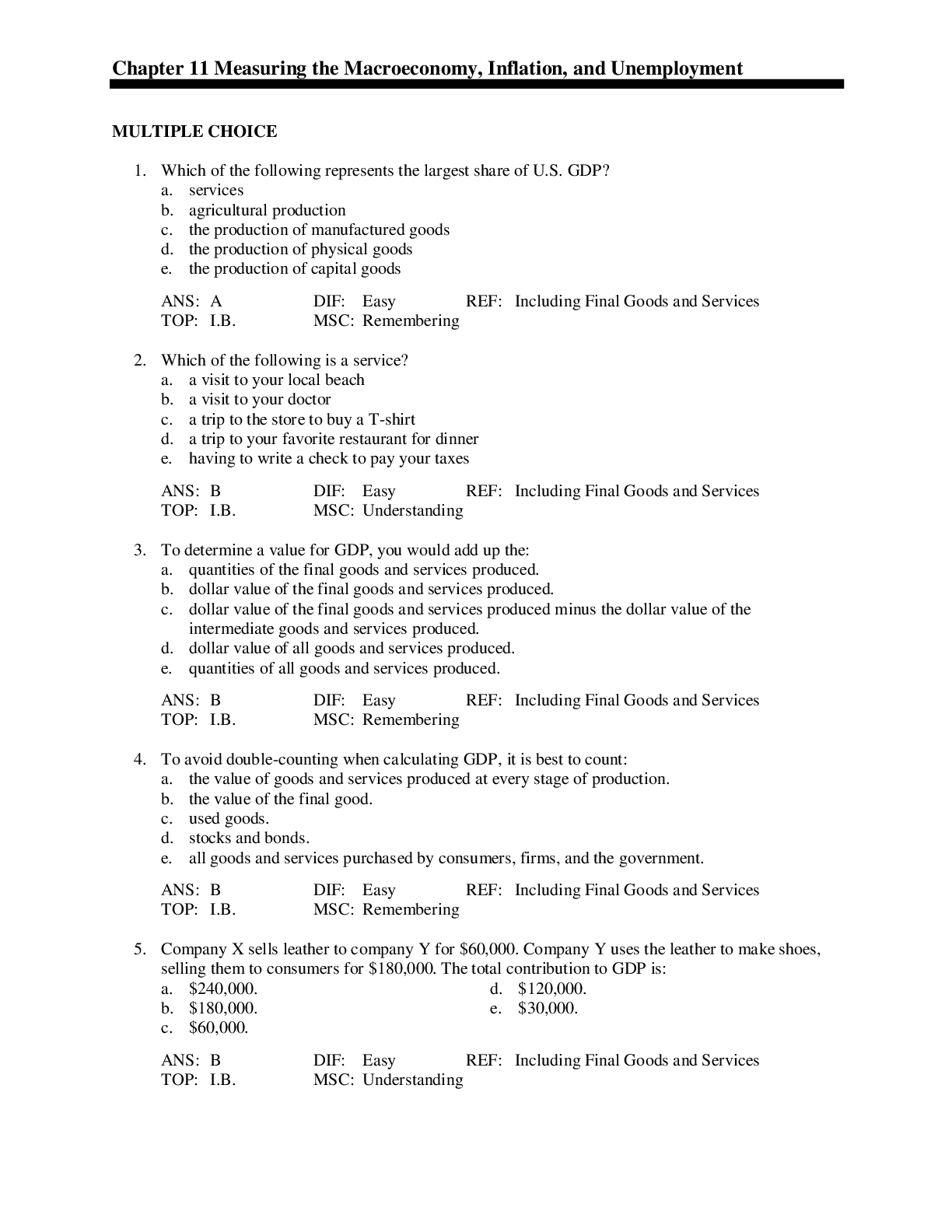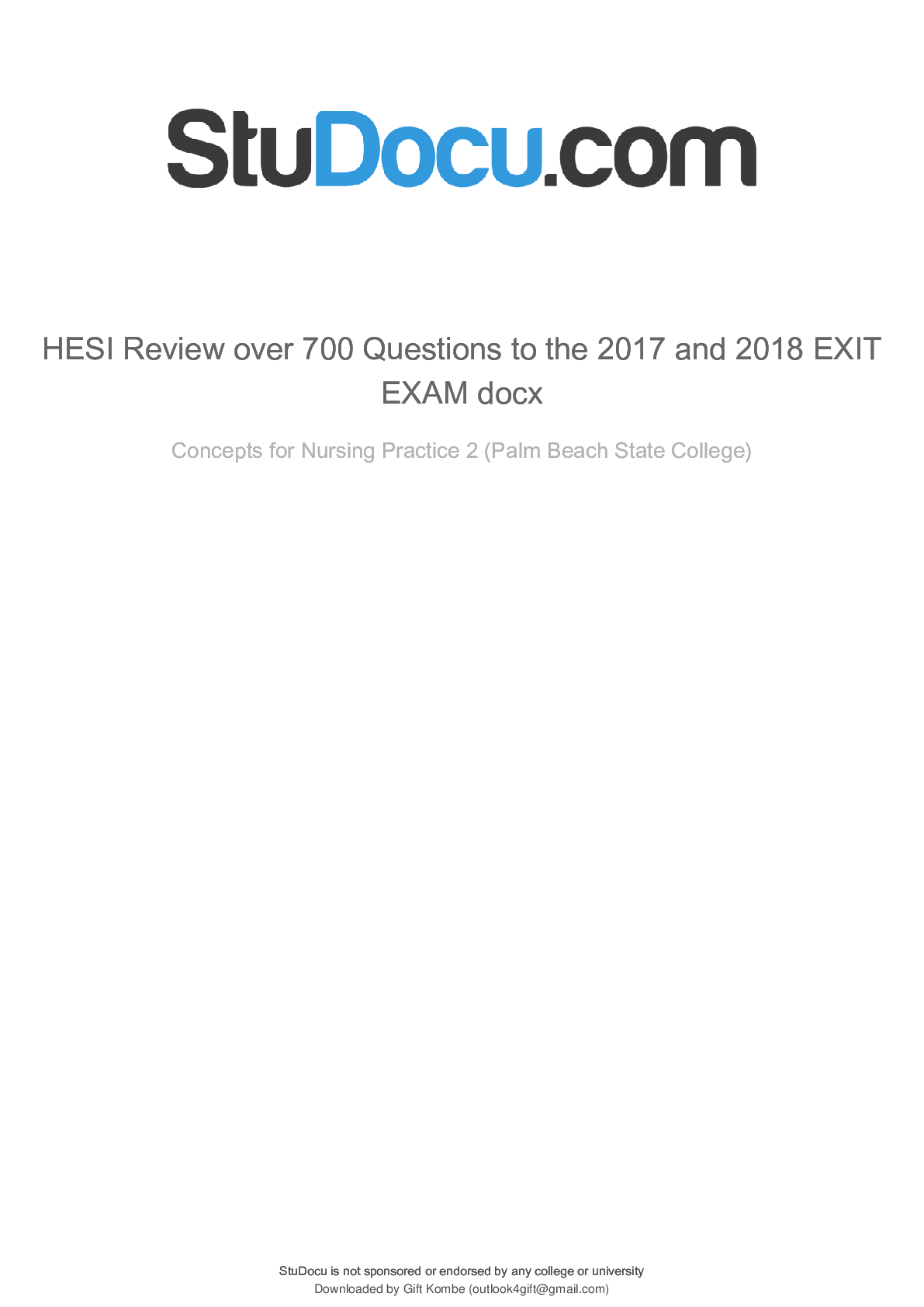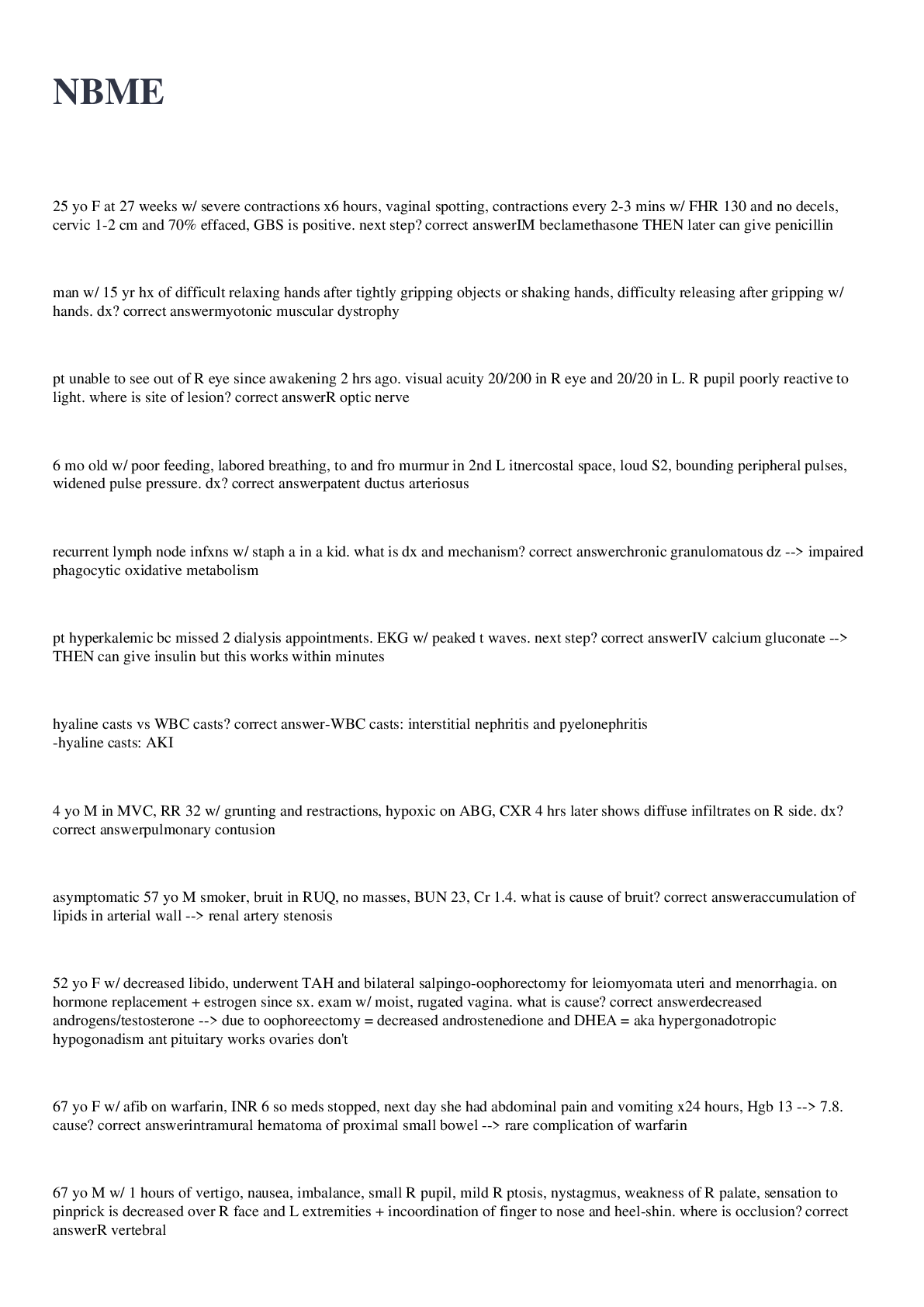ATI PHARMACOLOGY PROCTORED 200 QUESTIONS AND ANSWERS TEST BANK 2021/2022
Document Content and Description Below
1. A nurse is caring for a client who has a systemic infection. During the infusion of vancomycin, the client develops a rash and becomes flushed. Which of the following is an appropriate action for... the nurse to take? a. Obtain a prescription for oral vancomycin b. Decrease the rate of administration c. Document a penicillin allergy in the client chart d. Administer naloxone 1 mg IV 2. A nurse is caring for a client who is receiving penicillin by intermittent IV bolus. The client develops wheezing, dyspnea, cyanosis, and tachycardia. The nurse should administer which of the following medications first? a. Isoproterenol b. Epinephrine c. Prednisone d. Hydrocortisone sodium succinate 3. A nurse is caring for a client who is hospitalized for major depression and has a new prescription for citalopram. Which of the following adverse effects is the priority for the nurse to report to the provider? a. Bruxism b. Confusion c. Insomnia Weight loss 4. A nurse is caring for a client who has acute angina and has a prescription for nitroglycerin. Which of the following is an appropriate intervention for the nurse to take when administering this medication? a. Administer a nitroglycerin tablet sublingual every 5 min b. Replace the nitroglycerin transdermal patch every 4 hr c. Massage the nitroglycerin ointment completely into the skin d. Administer a sustained-released nitroglycerin tablet orally 5. A nurse is reviewing the medication of a client. The nurse should recognize that which of the following medications increase the client’s risk for constipation? a. Prednisone b. Hydrocodone c. Neomycin sulfate d. Lactulose 6. A nurse is caring for a client who has diabetes mellitus and is taking pioglitazone. The nurse should plan to monitor the client for which of the following adverse effects? a. Tinnitus b. Fluid Retention c. Orthostatic hypotension d. Insomnia 7. A nurse is assessing an older adult client who has cancer and is receiving morphine for pain management. The nurse should recognize that which of the following findings requires attention first? a. Respiratory rate of 10/min b. Bladder distention with no voiding in 6 hr c. Absence of bowel movement for 4 days d. Systolic blood pressure decrease of 20 mm Hg upon standing 8. A nurse is providing instruction to four clients regarding medication self-administration. Which of the following actions by a client indicates a need for further teaching? a. Client rolls insulin suspension between his palms b. Client allows 1 min between puffs when he uses a metered-dose inhaler c. Client takes iron supplements at bedtime d. Client uses cotton swab to apply antibiotic ointment 9. A nurse is assessing a client who takes prescribed daily aspirin. Which of the following findings indicates salicylism? a. Tinnitus b. Facial edema c. Diplopia d. Joint pain 10.A nurse is caring for a client who is receiving oral corticosteroids on a long-term basis to treat inflammatory bowel disease. Which of the following nursing interventions should the nurse take? a. Instruct the client to obtain annual immunizations b. Monitor the client for possible allergic reaction c. Monitor the client frequently for episodes of hypoglycemia d. Instruct the client to consume vitamin D supplements 11.A nurse is teaching a female client who has a new prescription for an estrogen-progestin combination. Which of the following adverse effects is the highest priority to report to the provider? a. Breakthrough bleeding b. Loss of appetite c. Calf swelling d. Breast enlargement 12.A client has an IV infusion of nitroprusside at 2 mcg/kg/min. The order to titrate the nitroprusside by 0.5 mcg/kg/min to maintain a mean arterial pressure (MAP) of 70 to 110 mm Hg. The client has a MAP of 120 mm Hg. The nurse should next titrate the nitroprusside to which of the following dosages? (Round the answer to the nearest tenth. Use a leading zero if applicable. Do not use a trailing zero.) 2.5 mcg/kg/min 13.A nurse is providing teaching to a client who has a new prescription for lovastatin. Which of the following client statements indicates an understanding of the teaching? a. “I should take the medication in the morning.” b. “While on this medication, I should increase my protein intake.” c. “I should come in weekly to have my blood checked for the first 6 months.” d. “If I develop muscle aches and tenderness, I should notify my provider.” 14.A nurse is caring for a client who has rheumatoid arthritis. The client is prescribed methotrexate. For which of the following should the nurse instruct the client to monitor and report to the provider? a. Insomnia b. Sore throat c. Urinary retention d. Constipation 15.A nurse is preparing to administer inflixlmab to a client who has rheumatoid arthritis. The nurse should monitor the client for which of the following adverse effects? (Select all that apply.) a. Polyuria b. Bradycardia c. Fever d. Jaundice e. Neutropenia 16.A nurse is providing teaching to a client who has a new prescription for phenelzine. Which of the following foods should the nurse instruct the client to avoid? a. Cheddar cheese b. Sweet potatoes c. Canned tuna d. Orange juice 17.A nurse is completing discharge teaching for a client who has hypertension. The client has a new prescription for spironolactone. Which of the following statements by the client indications an understanding of the teaching? a. “I’ll increase my dietary fiber, because this medication causes constipation.” b. “I realize that I should use sugar substitutes when taking this medication.” c. “I’m aware that this medication can cause heart palpitations.” d. “I’ll take aspirin every day, because it makes this medication more effective.” 18.A nurse is caring for a school-aged child who has been prescribed diphenhydramine. Which of the following adverse effects in the highest priority? a. Ataxia b. Dry mucous membranes c. Sedation d. Diarrhea 19.A nurse is caring for an older adult client who is NPO and receiving a continuous infusion of total parenteral nutrition via a central venous access device. For which of the following complications should the nurse assess first? a. Hypercalcemia b. Hyperglycemia c. Hyperlipidemia d. Hypernatremia 20.A nurse is caring for a client who has open-angle glaucoma and was prescribed pilocarpine 1 gtt of 3% solution. The nurse should recognize that which of the following findings indicates the client is developing systemic cholinergic toxicity? a. Tachycardia b. Salivation and sweating c. Stinging and burning sensation in her eye d. Hypertension 21.A nurse is assessing a client who has been taking anti-tuberculosis medications for past 3 months. The nurse should instruct the client to notify the provider if which of the following occurs? a. Weight gain b. Jaundice c. Polyuria d. Alopecia 22.A nurse is planning discharge teaching for a client who is to start therapy with repaglinide. Which of the following should the nurse include in the teaching? a. “Increase your protein intake.” b. “Hold the medication if your blood glucose is less than 120 mg/dL.” c. “Monitor for the irritability and diaphoresis.” d. “Take the medication 1 hour before mealtime.” 23.A nurse is evaluating a client’s response to a new prescription for phenazopyrdine. Which of the following is an expected client outcome? a. Decrease manifestations of GERD b. Increased ability to cough up secretions c. Improved movement of joints d. Relieved burning upon urination 24.A nurse is providing teaching to a client who is to start a new prescription for nitroglycerin sublingual. Which of the following client responses indicates understanding of the teaching? a. “I should allow the tablet to melt inside my cheek next to my gums even if it feels tingly.” b. “I should keep my tablets in a dark container at room temperature.” c. “I should call 911 when I am having chest pain, before taking a tablet.” d. “I should limit the number of tablets I take for chest pain to a total of two.” 25.A nurse is providing teaching to a client who has a new prescription for bumetanide for heart failure. Which of the following should the nurse include in the teaching? a. “You should monitor for hearing difficulties.” b. “You should take this medication on a empty stomach.” c. “You should take the medication at bedtime.” d. “You should decrease intake of foods high in potassium.” 26.A nurse is teaching about a prescription for a fentanyl transdermal patch to a client who has chronic pain. Which of the following should the nurse include in the teaching? a. Leave the old patch on for 12 hr after applying a new patch b. Take a short-acting opioid pain medication for breakthrough pain c. Change the patch every 24 hr d. The patch provides rapid release of the medication 27.A nurse is administering 4 mg of hydromorphone to a client by mouth every 4 hr. The medication is provided as hydromorphone 8 mg per tablet. Which of the following actions is appropriate for the nurse to take? a. Place the remaining half of the pill in the unit-dosage package b. Store the remaining half of the pill in the automated medication dispensing system c. Dispose of the remaining medication while another nurse observes d. Return the remaining medication to the facility’s pharmacy 28.A nurse is reviewing the medications of a client who is experiencing orthostatic hypotension. The nurse should identify this as an adverse effect of which of the following medications? a. Omeprazole b. Montelukast c. Imipramine d. Levothyroxine 29.A nurse receives a phone call from a client who has heart failure and reports a dry cough for the last week. After reviewing the client’s medical record, the nurse asks the client to come to the provider’s office. The nurse should then instruct the client to stop taking which of the following daily medications until he sees his provider? a. Lisinopril b. Nifedipine c. Hydrochlorothiazide d. Isosorbide 30.A nurse is caring for a client who requires medication for long-term pain management. The nurse should know that the use of acetaminophen is contraindicated for which of the following? a. Acute hepatitis b. Coronary artery disease c. Diabetes mellitus d. Ulcerative colitis 31.A nurse is caring for an older adult client who is taking prednisone for long-term treatment of rheumatoid arthritis. The nurse should monitor the client for which of the following adverse effects of this drug? a. Liver toxicity b. Hypoglycemia c. Hemolytic anemia d. Bone loss 32.A client who has Grave’s disease is prescribed methimazole. Which of the following effects should the nurse expect to see after the client has taken the medication for 2 months? a. Increased sleeping b. Increase in pulse rate c. Warmer skin d. Loss of weight 33.A nurse is assessing a client who has a prescription for cefaclor. Which of the following findings should the nurse recognize as an indication of an allergic reaction? a. Tremor b. Pruritus c. Hematuria d. Slurred speech 34.A nurse is planning teaching for a client who has leukemia and is receiving chemotherapy. The client is to taking allopurinol. The nurse should instruct the client that this medication will a. prevent cardiac toxicity. b. decrease uric acid levels. c. decrease blood glucose levels. d. prevent urinary tract infections. 35.A nurse is caring for a client who has an order for clozapine 350 mg PO daily. The nurse should recognize that which of the following findings is a side effect of this medication? a. Fast blood glucose of 220 mg/dL b. Weight loss of 2.26 kg (5 lb) in 2 weeks c. WBC 8,000 mm3 d. Serum sodium 136 mg/dL 36.A nurse is caring for a client who is postoperative following a total hip arthroplasty and has a prescription for enoxaparin. Which of the following actions should the nurse take? a. Massage the injection site after administration b. Expel the air bubble from the prefilled syringe before injection c. Inject the medication into the back of the client’s arm d. Hold the skin between the thumb and forefinger while injection the medication 37.A nurse is caring for an older adult client who has dehydration and acute renal failure. The client is receiving dextrose 5% and 0.45% sodium chloride IV at 150 mL/hr. For which of the following should the nurse immediately notify the provider? a. Blood glucose 188 mg/dL b. Carotid bruit c. Crackles in the lungs d. Sodium 148 mEq/L 38.A nurse receives a prescription to give tobramycin to a client daily. Which of the following laboratory values should t....................................................CONTINUED [Show More]
Last updated: 2 years ago
Preview 1 out of 31 pages

Buy this document to get the full access instantly
Instant Download Access after purchase
Buy NowInstant download
We Accept:

Reviews( 0 )
$22.00
Can't find what you want? Try our AI powered Search
Document information
Connected school, study & course
About the document
Uploaded On
Apr 18, 2022
Number of pages
31
Written in
Additional information
This document has been written for:
Uploaded
Apr 18, 2022
Downloads
0
Views
99





















